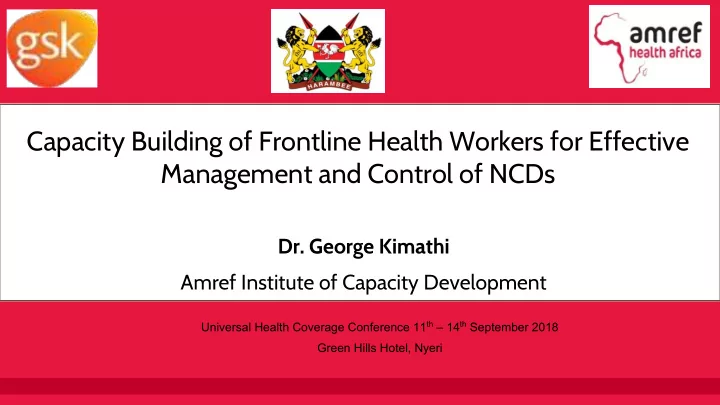

Capacity Building of Frontline Health Workers for Effective Management and Control of NCDs Dr. George Kimathi Amref Institute of Capacity Development Universal Health Coverage Conference 11 th – 14 th September 2018 Green Hills Hotel, Nyeri
Presentation Outline • About Amref Health Africa • Background • Our Approach • Results • Recommendations • Conclusions
Headquartered in Nairobi, Kenya Country Offices in Africa 10 offices Number of projects in Africa >150 projects People reached across Africa annually ~12m people 1,500 staff $115m Revenue (2018) Annual budget ~$100m Subsidiaries: • Amref Flying Doctors • Amref University • Amref Enterprises
The Institute of Capacity Development Vision: A responsive health workforce in Sub-Saharan Africa Mission : To develop the capacities of individuals, institutions and health systems through innovative approaches for improved health service delivery. Innovative Health Increase Strengthen Innovate and Learning numbers and capacity of incubate ideas in Solutions priority skill sets health training health institutions and • Partner with • Senior, mid-level • Identify organizations countries to and community innovative ideas, • Curriculum develop and level specialized mentor deploy innovative courses review, content entrepreneurs, HW training development, link with financing solutions e.g. faculty institutions e&mLearning preparation, Operations Research
The Gap in Management and Control of NCDs Kenya’s Ministry of Health estimates 53% of all hospital admissions are NCD related. – Type 2 diabetes is estimated at 4.2% and ranges between an average of 2.7% in rural and 10.7% in urban areas; Asthma affects approximately 10% of the total population • Health workers are too few currently employed are 43 612 against a standard of 282 525 healthcare workers required as per the Norms and Standards Guidelines by MOH therefore 62% shortage. • Inadequately skilled to effectively treat and manage complications of NCDs with only 39.9% trained on NCD management • Laboratories not able to screen NCDs due to lack of basic equipment and supplies • Low community and public awareness hence minimal demand for services. • Lack of accurate population-based data for decision making.
Our Journey in HRH Capacity Development …
The Scope Overall Aim: To improve the management and control of non-communicable diseases (diabetes and childhood asthma)
Objectives 2. To strengthen community-based disease surveillance to increase public awareness for prevention and better management and control of diabetes and asthma. 3. Monitoring and Evaluation 1. To train frontline health to generate and use evidence workers for effective for Policy and Practice management and control of Change for quality care. NCDs.
The Approach GOAL Reduced morbidity and mortality due to NCDs & IDs Prevention Advocacy • Health Promotion • Continued advocacy Advocacy • Promoting healthy diet, physical activity, reduced • Advocacy for for diagnostic tools Training HRH alcohol and cessation of supplies and • Strengthen TWGs for • eLearning tobacco use Interventions NCD medicine • Face to face training • Community disease • Sharing lessons for • Inclusion of NCDs • OJTs and CMEs surveillance Project in AWP policy change • Leadership, management & • Improve disease Collaborations Capacity development governance (LMG) • Build • Mentorship surveillance and • CHWs and CHEWs training multi-stakeholder • Advocacy for NCDs Supplies, screening services through Leap equipment and medicines • Strengthening partnerships for • Community screening referral system NCDs management • Referrals Community level Health Facility Level County Level National level strategies • Training of Human resources for Health (HRH): through face to face, e&mlearning Project • Community health sytsem strenthening (CHSS) • M & E: to generate and use evidence for advocacy to influence action & policy for effective service delivery to prevent, treat, and control infectious diseases. • Double burden of NCDs • Few & Inadequately skilled HRH • Low priority to • Underfunding Gap • Low community awareness • Lack of basic equipment NCDs • Poor health seeking behaviors • Limited access to medicines & supplies • Poor adherences to treatment • Weak referral systems
Results Per County Per Cadre County Skilled Cadre Skilled Nutritionists 144 Kilifi 649 Lab. Techs 139 Clinical Officers 293 Nyeri 629 Nurses 447 Nairobi 710 Pharm. Techs 100 CHAs 233 Kakameg 625 CHVs 1170 a Health managers 87 Total 2613 Total 2613
The Ripple Effect of Capacity Building Skilled 2613 frontline health workers Reduced Equipment & 4 million people Improved frequencies of Over 100 NCD commodities by reached with knowledge & hospitalization due clinics and support counties(inhalers, services Skills (40% - to elevated sugars groups peak flow meters, 96%) or asthma attacks glucometers, insulin,..
Proposed Next Steps….. 1) Strengthen diagnostic and reporting tools for NCDs in order to generate evidence for decision making 2) Community sensitisation needs to be scaled up – prevention, promotion, screening, demand for services 3) Supply chain - There is need to ensure supply meets the demand for NCD commodities which are limited at the moment 4) Innovate and Replicate – Scale up capacity building and strengthen community health systems to improve access of services at grassroots level 5) Address NCD co-morbidities - health workers should be aware of the wide spectrum of comorbidities to optimize patients health outcomes. E.g Diabetes and hypertension.
Conclusion i. Capacity building creates a ripple effect in the continuum of care from prevention to treatment and supply chain. It was clear that those health facilities whose health workers were trained/mentored included NCD supplies and drugs in their procurement plans ii. There is need then to replicate this and scale up to other regions with high burden of NCDs as well as intensify advocacy for NCDs due to its rising burden. iii. Technology , provides leverage to reach a larger group that would otherwise be impossible via conventional capacity building approaches
Take Home? 1) Increase prioritization for NCDs through increased budgetary allocation 2) Ensure availability and affordability of NCD medication to match the demand for the same at facility level 3) Continuous Capacity building for frontline health care workers – (at health facilities and community level)
Thank You! Questions? Additional info? Dr. George Kimathi Website: www.amref.org Email: George.Kimathi@amref.org
Recommend
More recommend